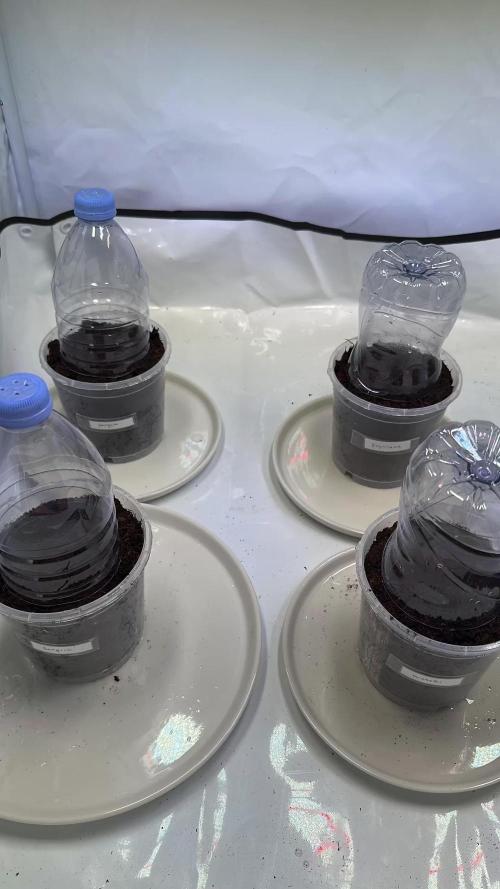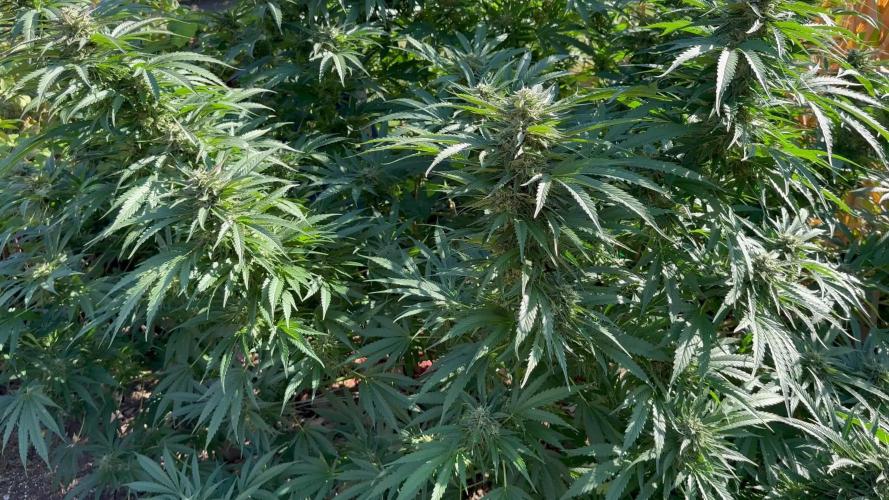The Grow Awards 2026 🏆 





























Likes
Comments
Share


@HeitorLeao
Follow
Anandamida is suffering from trips attack, but can't do anything now
Likes
62
Share


@masterofsmeagol
Follow
7/12 Soil was a little damp so I watered lightly only what looked like it needed it. Dr. Zymes seems to have no negative effects. Plants just look super clean. I still saw some patches of PM and I only had the free samples so I'm going to have to use another product in conjunction to treat this. Overall I'm pretty impressed with the Dr. Zymes. HAD MY VIDEO AND TONS OF PICS UPLOADED BUT THIS SITE WOULDN'T ALLOW ME TO SAVE. I'LL UPLOAD THE REST LATER "IF" THIS EVEN ALLOWS ME TO SAVE. Went back over at three and watered the girls. Everything looks amazing. Trying to upload video now.
7/13 Didn't water this morning. Plants look fantastic. Went over at 4:30pm. Things looked great. Definitely stretching. I took some good pictures. Didn't water as plants seemed VERY happy and soil still had a little moisture. I gave them a touch of kindness which means I gave them a tiny bit of water to hold them over until morning. I know this is not a good practice to get into but I didn't want to come back to wilting plants. The little seedlings are turning more lime green (which isn't good) and have some yellow leaves. They have recycled soil from last grow. May need to feed more. I went through them and moths flew everywhere. We have a major brown tail moth problem here. I know I just sprayed Dr. Zymes but I'm going to have to spray BT. I must've seen at least half a dozen moths. On just those three tiny plants. Still struggling with PM.
7/14 Went to the garden briefly this morning. It rained last night and was drizzling while I was there so I obviously didn't water. Its still sprinkling and I'll be over there later to check. Plants are really stretching into "the asparagus" stage as I like to call it lol. What will eventually be a bunch of colas stretch into what I think looks like asparagus spears. That may be part of the reason why some of the leaves turn yellow and die in the lower middle canopy during this time. Everything looks great though and I certainly have plenty of leaves. I looked at last year's diary at this date and got some relief noticing the same things happening last year at the same time of year. UPDATE: Went back to the grow as the "rain" and "thunder showers" weren't producing much water. I checked the soil and it seemed to have dried out some (more on smaller bags) and hadn't FULLY watered the plants. I watered lightly. I listened and I could hear the water work it's way down the medium. Even if it pours tonight plants will be ready for a feed tomorrow. The 3 little ones in buckets outside especially. I have work to do tomorrow.
7/15 It's overcast today and looks like rain. Forecast called for a nice sunny day. Anyway I fed two gallons to nutes to the garden and did some slight defoliation. I had to hurry as I had a doctor's appointment. I have branches that need to be tied down and plants need to be cleaned up a bit. If it's not raining I may do a preventative BT spray. We have a HORRENDOUS outbreak of brown tail moths. I don't think the bother cannabis but they are poisonous and the rash that develops is hell. 90 degrees at 6:30 plants weren't totally dry but the top inch or so was so I gave them a good drink. Took some pictures and a video I'll upload when I have a better connection. Cop was watching me. Good thing I'm in a legal state and my grow is totally on point.
7/16 No water this morning. Soil was still wet. Plants are looking good. Will update more later on. Defoliation, pruning and spraying are on the agenda. Made a video and took more pictures but internet is spotty and doesn't want to upload. Went back and watered lightly before a massive thunder storm dropped sheet rain for like an hour. Internet is still slow so I'll have to wait till tomm to upload.
7/17 No water. Brown tail moth rash is driving me crazy. Plants still stretching and look overall healthy. Defoliated some this morning. Will update more later. Went back over and gave a little water before it began to downpour.
7/18 Raining with what looks like more rain in the forecast. Good. Hopefully will help me lower the pH a little. I didn't take pictures or even go in the cage this morning. This brown tail moth rash has me scared lol. It really sucks. Makes poison ivy seem pleasant. When rain stops BT will be sprayed.
Likes
13
Share


@NanoLeaf
Follow
Started Training Late!
Was on summer holiday for a week and only started training now. Above are the plants during training as well as a few hours after training.
Autos are definitely more delicate and the two runts are growing slow but yet still showing some progress.
Changed my bulbs back to the CMH set to 400w each (2)
Also gave them a good amount of water as the FloraCaps aren’t covering the whole pot I felt like it was necessary to wet the entire grow medium well for a change.
Some of them were a bit far along for training but I did the best I could.
Also the Purple Lemonade and 2 other plants are showing signs of flowering.
Likes
4
Share


@420rollweek
Follow
Seeds directly In coco jiffy
Bruce banner seed spend more time then other 2 to get out...
Likes
52
Share


@MagicoVerde
Follow
Last week and flushing time using flawless finish from an and flushing with proper ph water 6 h later after applying the product . Can’t be more happy, plant Gad respond really well to all the stages and it’s as expected, and ve say the buds luckily got bigger than expected and the smell is brilliant.
Definately I’ll grow it again 😊
Likes
17
Share


@Sergio_721
Follow
as you can see the girls are growing despite having had and I think deficiencies from the beginning of flowering but I have increased the dose of nutrient and the first results are starting to show. they started forming flowers so i still think 3-4 weeks to cut we will see next week if we start flush and hope for a decent harvest 🌱
Likes
13
Share


@FlavoursUk
Follow
New week, new growth.. Will hopefully start the LST and Topping in a few days. They are really starting to grow. Fan leaves looking healthy and big.
Girls coming with vigorous growth now, everything dialled in and happy. Just adjusting the EC/pH as needed when the girls show me the relevant signs/deficiencies if any.
D31/D35- Decided they were in a good enough place to start topping the girls, all 6 topped and just some defoliation of the bigger fan leaves that are shading the growth shoots some HST was also done.
We were also due a water change, so I cleaned the whole system just to keep things extra cleanly, very important in a RDWC system. I also switched over to a sterile system instead of using beneficial bacteria so I will experiment and see how this goes.
Time to let the girls ecover before the next training session.
Cruise control for now.
Likes
4
Share


@weedoloco
Follow
Everything s normal. But I think there will have not enough... 😓🌱🌱🌱
So have be careful for nutrition and health of them ✨💦💡
Likes
23
Share


@Susquihanna
Follow
FBA 2025 turned Frostbanger was a fun grow in many ways. First, my friend gifted me the seed and I grew outside while she grew inside. It was fun to watch the plants grow in different settings and different growing methods. If you have been following me, then you know our weather has been crazy here. We have had lows of 50* and highs of 90*. We had a hail storm and lots and lots of rain. Today, I was. forced to take my Frostbanger down. I found a couple of buds rotting and it is supposed to rain for the next 4 days, so this grow has come to an end. But first, true to Frostbanger's description, "Just keep in mind, this strain’s dank, pungent odor is super strong—meaning a carbon filter is a must to mask the aroma in any grow room and she’ll make her presence known when grown outside" and boy did my backyard smell.
Also, just like its name, it is a "trichome-studded beauty." Sticky, sticky, sticky. It also had a nice fruity smell, almost like a cantaloup.
I like to wet trim, so I spent the past 2 days trimming. My wet bud weight is 102.19 ounces. Not A big harvest. Had to throw away some bud rot and I had to take this plant down early --But that is how a hail storm, cold weather, hot weather, Rain and more rain will effect a harvest. I'm happy to be somewhat successful.
FYI: today's weather: It has rained 2.05 inches in the past 24 hours and expecting 1.6 inches in the next 24 hours..
I am pretty proud of Frostbanger's cola as it is 10 inches long and approximately 9 inches around. Wish I could have seen it with 2 more weeks of growth.
I may not have the growing experience of others, but I am super happy with this grow and glad I could enter a contest. It was fun!
Likes
31
Share


@RFarm21
Follow
Olá growmies!
Foi alimentada dia 19Dezembro com 2.5l de água.
É a primeira vez que estou a usar alg a mic da biobizz para ver se a planta n stressa tanto.
Perguntei à empresa biobizz quais eram os valores ideais de E.C e eles responderam que os medidores de E.C não são muito fiaveis porque os nutrientes são 100% orgânicos. Recomendaram seguir o schedule deles e ter em conta aquilo que a planta nos pede.
Feliz Natal e boas colheitas!
Likes
3
Share


@Mr_nugs_lover_David
Follow
On August 19th I decide to apply supercroping technique to get much more sunlight penetration in the whole canopy, let's see how she turns out, she's pretty big to be planted late in the season,looks fenomenal and very healthy,I also applied a defoliation now that we are in second week to get that the light gets to every single flower site. 🌸💚❤️💛
Likes
117
Share


@Ageddd
Follow
B L A C K
D O M I N A
H A R V E S T
_________________________________________
Whats up Growdiaries !!
It was a week ago since i harvested Ms Black Domina 7/10 - DAY 59 - . I have been busy so i couldnt update...
Not yellowing at all... only lost a bunch of leaves, maybe she had a lot of nutrients.
She was very hard to trim (even harder than i thought), so i needed some help..and my friends were there :))
We spent like 4 hours or more, i cant imagine if i would do it alone... So if they are reading this Thanks again bros!!!
A lot of leaves that were hiding a beautiful treasure... that buds.
It has been drying like 10 days so yesterday i weighted it all together.. I really dont care about weight but i care about quality seems pretty good, i smoked dried buds and they taste like incense-hash, dense air that you notice, leaving a smooth spicy paladar and tongue flavor, good high and good couchlocking, high is psychoactive and later couchlocke, so im happy with that effects. But were not cured so imma make a better smoke report a week later..
I wanted to say thanks to all growers here that are helping others and learning, seriously, this is one of the less
toxic communities i have ever seen. Nice work and nice people here. Of course this is because GrowDiaries platform, good site politics, admins and growers, all together!!
:)
I tried to make a good video to see a complete harvest process.
(All rights reserved to Hans Zimmer, if copyright watchdogs are following me.. i hope they arent lool)
---------------------------------------------------------------------------------------------------------------------------------
Weight: 2.5 kg wet / 650 gr dried, but there are a few sticks. Tiny leaves i left are full of thc.
Only weighted good buds.
Bigger buds : 220gr
Medium Buds : 310gr
Small buds (EDITED: As first i thought it would be 20-30 but finally 120gr :))))(lower part of the plant, less formed)(Thats what im smoking as sample, curing in jars): 120gr.
- That makes a total of 650 gr untouched more grs smoked as samples. All well dried.
That tiny room with lights is where plant spend first month, growing indoors in a selfmade room.
----------------------------------------------------------------------------------------------------------------------------------
I hope you all enjoyed this lady, Ms Black Domina. I highly recommend it to indica lovers, its a pleasure to grow and smoke this strain...
----------------------------------------------------------------------------------------------------------------------------------
.
Likes
563
Share


@Ju_Bps
Follow
Hello my friends 👩🌾👨🌾,
This 4th flowering week was good, girls are sweets and healthy, we have nice leaves purple 💜, Buds continue to be along and start to bump.
I've found some thrips and lot of flyer 😑😑, several month I was without this fkg bug, but they're back..
I don't know if I do a treatment this week or if I wait the harvest to clean...
And daily fighting with leaves to kick off them under.
💦 2 Watering this week 1.5l/plant .
Water + Terra Flores + Canna Boost
Water + Cannazym + Sugar Royal
PH@6
Lamp @100%
Bisous 💋😘, and see you next week.
Thanks community for follow, likes, comments, always a pleasure 👩🌾👨🌾❤️🌲
Mars Hydro - TS 1000
https://www.mars-hydro.com/ts-1000-led-grow-light
Mars Hydro - FC3000
https://www.mars-hydro.com/fc-3000-samsung-lm301b-led-grow-light
Mars Hydro - SP3000
https://www.mars-hydro.com/sp-3000-samsung-lm301b-greenhouse-led-grow-light
The High Chameleon - Bisous Au THC 💋💋🌲🌲😘😘
https://www.thehighchameleon.com/shop/bisous-au-thc-83
Likes
9
Share


@Ryno1990
Follow
Today starts my flush week for this beautiful wedding glue from fastbuds the gelato is budding really nice an should only have another week or two before flush time
Likes
34
Share


@J4kpvp
Follow
Hello:)
The plants are progressing nicely. The wasabi is almost ready but the sangrias need at least one more week. Let‘s hope the wasabi won‘t be too much overripe by then:)
Sadly the red/purple buds don‘t seem to spread more to the top buds, I suspect that the temperature difference between day and night is not enough, let‘s see if they get more color this week.
I plan to harvest between the 18.11-22.11 if the sangrias are ready, the wasabi will have to hang in there:)
Also, here is the video so far:) next time i‘ll try to make a fix spot for the camera































